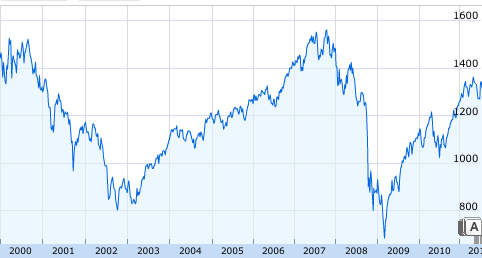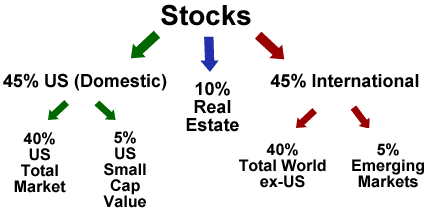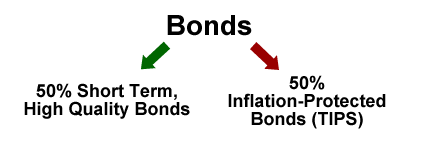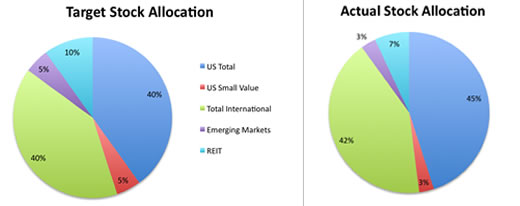 No, this not another book on gratuities and service workers. In the investing world, TIPS stands for Treasury Inflation-Protected Securities, which are bonds issued by the US government that pay interest which is linked to inflation. Inflation is measured by the Consumer Price Index (CPI).
No, this not another book on gratuities and service workers. In the investing world, TIPS stands for Treasury Inflation-Protected Securities, which are bonds issued by the US government that pay interest which is linked to inflation. Inflation is measured by the Consumer Price Index (CPI).
As a greatly simplified example, if you bought a TIPS bond with a real yield of 2% and inflation ends up at 3%, your return would be 5%. If inflation later on jumps to 8%, your return would be then 10%. Most bonds are what we call nominal bonds. They pay a certain interest rate like 5%, regardless of what inflation is. Thus, having such inflation-linkage provides protection against inflation that is higher than expected.
These are just the basics. A cynic would tell you that you don’t hear much about TIPS because they don’t make Wall Street very much money. However, I think they are a critical component of my portfolio. So how should you go about buying them? Enter the book Explore TIPS by the anonymous blogger and former guest poster The Finance Buff. For example, it will show you how to navigate the many different ways you can buy TIPS:
- Via a mutual fund or ETF like VIPSX or TIP
- Via an official auction through TreasuryDirect or a broker
- Via the secondary market, through a broker
As with many things, buying them directly gives you more control, but less convenience. The good thing is that like Treasury bonds, holding a single bond has the same credit risk as holding 100 of them. However, you’ll need to understand things like noncompetitive bids (actually a good thing), yield-to-maturity, and inflation factors.
Even though it’s only about 100 pages long, Explore TIPS definitely comes through as its tagline promises: “A Practical Guide to Investing in Treasury Inflation-Protected Securities”. It may take a while to get through… even I don’t get excited about reading about bonds. Well, maybe a little. 😉 Now, you could probably learn most of this stuff on your own if you spent all your time browsing investment forums and the Treasury website, but this tidy reference book will save you loads of time. On Amazon it currently runs $11.96, but you can buy the PDF version for $4.95.


 There are many changes to health care that have come and are coming from the Affordable Care Act. For example, if you are a young adult looking for health insurance, you can now be covered under your parent’s plan (if it covers children) until you turn 26 years old. (See here for more info.)
There are many changes to health care that have come and are coming from the Affordable Care Act. For example, if you are a young adult looking for health insurance, you can now be covered under your parent’s plan (if it covers children) until you turn 26 years old. (See here for more info.)



 Netflix users around the country are abuzz about Netflix’s new pricing plans. Previously, all DVD plans included unlimited internet streaming. Late last year the prices were upped slightly to $10 a month for 1 DVD out at a time, $15 for 2 DVDs, and $20 for 3 DVDs. (I’m rounding because I think .99 pricing is annoying.) Coming September 1st, 2011, Netflix has separated the DVD and Streaming options completely. Streaming is $8 a month, and there is no discount if you add it to a DVD plan. 1 DVD at a time is $8, making the total now $16 month – a 60% price hike. 2 DVDs at a time is $12, making the new total $20 a month, a 33% price hike.
Netflix users around the country are abuzz about Netflix’s new pricing plans. Previously, all DVD plans included unlimited internet streaming. Late last year the prices were upped slightly to $10 a month for 1 DVD out at a time, $15 for 2 DVDs, and $20 for 3 DVDs. (I’m rounding because I think .99 pricing is annoying.) Coming September 1st, 2011, Netflix has separated the DVD and Streaming options completely. Streaming is $8 a month, and there is no discount if you add it to a DVD plan. 1 DVD at a time is $8, making the total now $16 month – a 60% price hike. 2 DVDs at a time is $12, making the new total $20 a month, a 33% price hike. According to a
According to a  The Best Credit Card Bonus Offers – March 2024
The Best Credit Card Bonus Offers – March 2024 Big List of Free Stocks from Brokerage Apps
Big List of Free Stocks from Brokerage Apps Best Interest Rates on Cash - March 2024
Best Interest Rates on Cash - March 2024 Free Credit Scores x 3 + Free Credit Monitoring
Free Credit Scores x 3 + Free Credit Monitoring Best No Fee 0% APR Balance Transfer Offers
Best No Fee 0% APR Balance Transfer Offers Little-Known Cellular Data Plans That Can Save Big Money
Little-Known Cellular Data Plans That Can Save Big Money How To Haggle Your Cable or Direct TV Bill
How To Haggle Your Cable or Direct TV Bill Big List of Free Consumer Data Reports (Credit, Rent, Work)
Big List of Free Consumer Data Reports (Credit, Rent, Work)